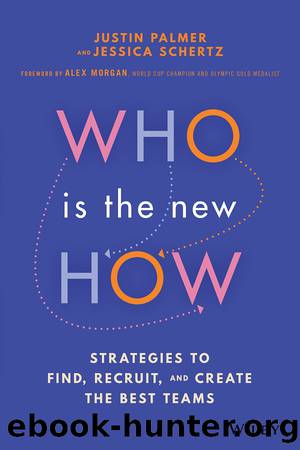Who Is the New How: Strategies to Find, Recruit, and Create the Best Teams by Justin Palmer & Jessica Schertz

Author:Justin Palmer & Jessica Schertz [Palmer, Justin & Schertz, Jessica]
Language: eng
Format: epub
ISBN: 9781119899075
Publisher: Wiley
Published: 2023-04-24T00:00:00+00:00
The Office
We think of old recruiting methods in the same way we think of old search engines: not efficient, not userâfriendly, and not good at understanding what you're really looking for. We don't fault old recruiting methods though. They're ⦠old. They go all the way back to 1650.
The first officially documented recruitment agency was started by Henry Robinson. He was a noted religious dissenter, philosopher, merchant, writer, and sometimes government official when he opened the brand new and unusual business on Threadneedle Street in London: the Office of Addresses and Encounters. At the Office, for a modest fee of sixpence, individuals could record their addresses and what services they could offer, and businesses could list what needs they might have. (For the same fee, the Office also provided answers to other types of queries: lodgers could find accommodations, hardâtoâfind merchandise was matched with buyers, and the lovelorn could find companionship. So in addition to recruitment, Robinson basically invented Airbnb, eBay, and Match.com.)
Two hundred years later, specialized and privately owned agencies began to pop up. In 1883, John Gabbitas recruited schoolmasters for public schools in England. In 1890, the Mrs. A. E. Johnson Employment Agency hired lady's maids, parlor maids, and footmen for the upper class in the United States (including Roosevelt, Carnegie, and Rockefeller). In 1893, Fred Winslow started an engineering agency. In 1906, Katherine Felton opened an agency after the San Francisco earthquake and fire, which killed more than 3,000 people and destroyed over 80% of the city.3
But what most would consider modernâday recruitment started during World War II when agencies were set up to fill gaps left in the workplace after men were called to join the war efforts. With so many vacancies to fill, staffing agencies and professional job recruiters mined a gap, helping to match individuals to suitable positions. After the war, returning soldiers needed to find employment and large corporations were growing steadily with the return of the American consumer. The result was a hiring frenzy that led to even more agencies.
To find or publicize a job, newspaper advertisements or physical job boards were standard. Agencies would scour these resources on behalf of job seekers, and also coldâcall companies to see about their hiring needs. Candidates were encouraged to write résumés, which needed to include specifics like age, weight, height, marital status, race, religion, and health conditions. While résumés used to just be formalities written on scrap pieces of paper, by 1960 they were expected and people agonized over everything from whether they should lie about their singledom to how to get enough copies if they didn't have access to a photocopier.
Fun fact: Leonardo da Vinci is widely credited with drafting the first ârésuméâ in 1482 in the form of a letter written to the Duke of Milan to gain his patronage. Proving he was as skillful in his job search prowess as his artistic talents, da Vinci made sure the letter focused on the strengths he had that were most clearly aligned with the Duke's needs.
Download
This site does not store any files on its server. We only index and link to content provided by other sites. Please contact the content providers to delete copyright contents if any and email us, we'll remove relevant links or contents immediately.
| Ethics | Etiquette |
| Fashion & Image | Health & Stress |
| Motivation & Self-Improvement | Work Life Balance |
| Workplace Culture |
Tools of Titans by Timothy Ferriss(8222)
Change Your Questions, Change Your Life by Marilee Adams(7637)
Deep Work by Cal Newport(6885)
Playing to Win_ How Strategy Really Works by A.G. Lafley & Roger L. Martin(5931)
Man-made Catastrophes and Risk Information Concealment by Dmitry Chernov & Didier Sornette(5924)
Digital Minimalism by Cal Newport;(5667)
Big Magic: Creative Living Beyond Fear by Elizabeth Gilbert(5615)
The Slight Edge by Jeff Olson(5352)
Ego Is the Enemy by Ryan Holiday(5295)
The Motivation Myth by Jeff Haden(5157)
Stone's Rules by Roger Stone(5027)
The Laws of Human Nature by Robert Greene(5001)
Tuesdays with Morrie by Mitch Albom(4695)
Eat That Frog! by Brian Tracy(4436)
Rising Strong by Brene Brown(4380)
Skin in the Game by Nassim Nicholas Taleb(4165)
Bullshit Jobs by David Graeber(4100)
The Money Culture by Michael Lewis(4082)
Skin in the Game: Hidden Asymmetries in Daily Life by Nassim Nicholas Taleb(3935)
